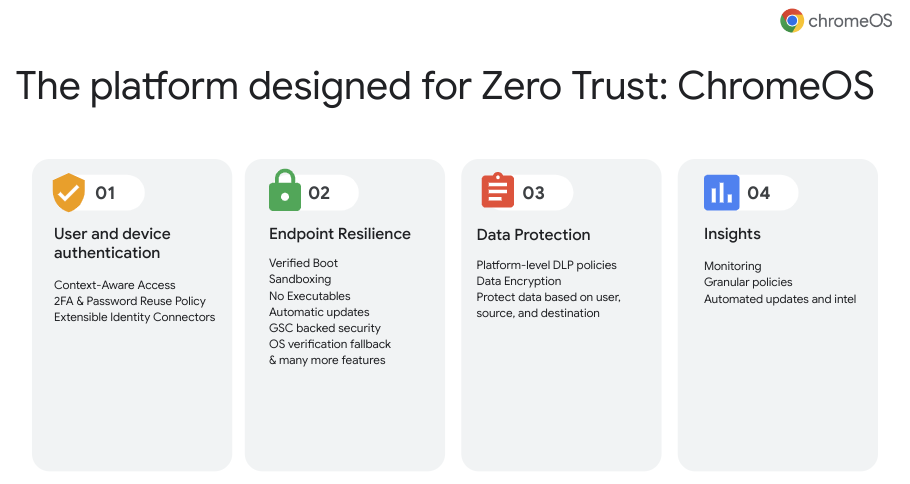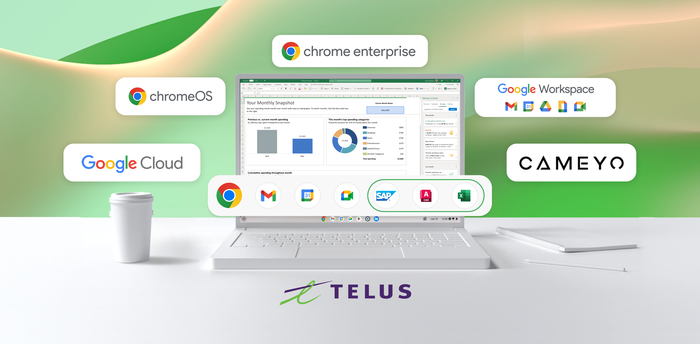ChromeOS: The platform designed for Zero Trust security

Tony Ureche
Director, Product Management ChromeOS
In today's ever-evolving threat landscape, traditional perimeter-based security models are no longer sufficient. Work has expanded beyond the bounds of corporate networks, as work happens today in airports, coffee shops, at home, and even in mobile healthcare stations. Meanwhile the threats are increasing in volume and sophistication, with ransomware posing a threat to businesses of all sizes. Organizations need an adaptable security strategy that proactively anticipates threats rather than waiting to react.
That's where Zero Trust comes in – a philosophy revolutionizing cybersecurity at modern organizations. The old adage "trust but verify" is outdated. The Zero Trust model operates under the principle of "never trust, always verify." It assumes that threats can originate from anywhere, both inside and outside the traditional network perimeter.
At ChromeOS, we implement Zero Trust cybersecurity through these principles:
- Anticipating Attack. Assume that attackers will target your organization and set up a proactive security strategy that protects users, data and devices. Minimize the attack surface, store data in the cloud, and explicitly ensure device security before granting access.
- Robust Authentication. Every access attempt must be verified before they are authorized. Instead of basing access on corporate network enrollment, robust authentication means considering a number of different signals like device health, user location, and attempted actions.
- Proactive Monitoring. Continually monitor your device and data landscape to identify anomalies. Ensure complete visibility over sensitive data, where it originates, how it moves across the network, and who has access to it. Collect insights into device usage, application behaviors, and emerging threats. Use this data to proactively adjust policies, address vulnerabilities, and respond quickly to potential attacks.
Defense Vectors
Endpoints, like laptops, smartphones, and IoT devices, represent a major attack surface. ChromeOS was built to fulfill all the needs of an organization that runs on Zero Trust principles.


- User and Device Authentication: On ChromeOS, cloud accounts are inseparable from the user experience. Every ChromeOS device includes a Google security chip providing a strong hardware-backed identity, ensuring that only trusted devices can access your resources.
- Endpoint Resilience: ChromeOS provides multiple layers of protection on the endpoints themselves, ensuring that a breach of one defense doesn't automatically compromise the entire system.
- Data Protection: Protect sensitive data at the platform level on ChromeOS, enforcing rule-based policies, depending on the data destination, source or user group that can prevent copying, USB download, and printing or screenshotting
- Insights: With granular reporting in your security dashboard of choice, starting with Google Admin Console or CrowdStrike Falcon LogScale, organizations can monitor device events, user behavior, and the movement of sensitive data across their landscape.
Zero Trust with zero hassle
ChromeOS is custom-designed to make Zero Trust security simple and easy to implement. Features like Verified Boot and Sandboxing come ready to go out of the box and secure data, devices, and users across hybrid workscapes. On-device data is encrypted by default safeguarding it against unauthorized access, even if a device is lost or stolen.
ChromeOS security features create a hardened operating environment resistant to common attack vectors, making it harder for threats to take hold. ChromeOS device management streamlines updates, policy enforcement, and device monitoring, reducing administrative overhead and enabling consistent security across the enterprise.
ChromeOS is the platform designed for Zero Trust security. It helps organizations make the transition to Zero Trust with ease, affordability, and speed.
Learn how ChromeOS can simplify your Zero Trust journey today



